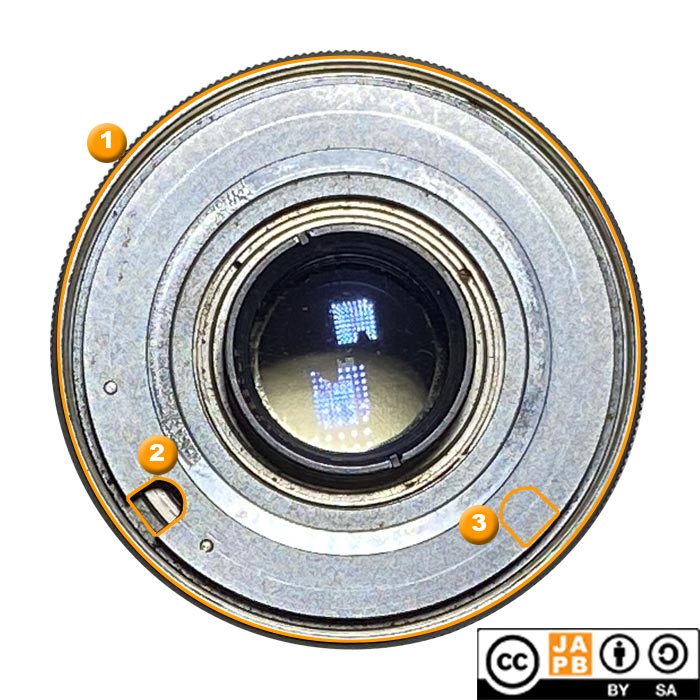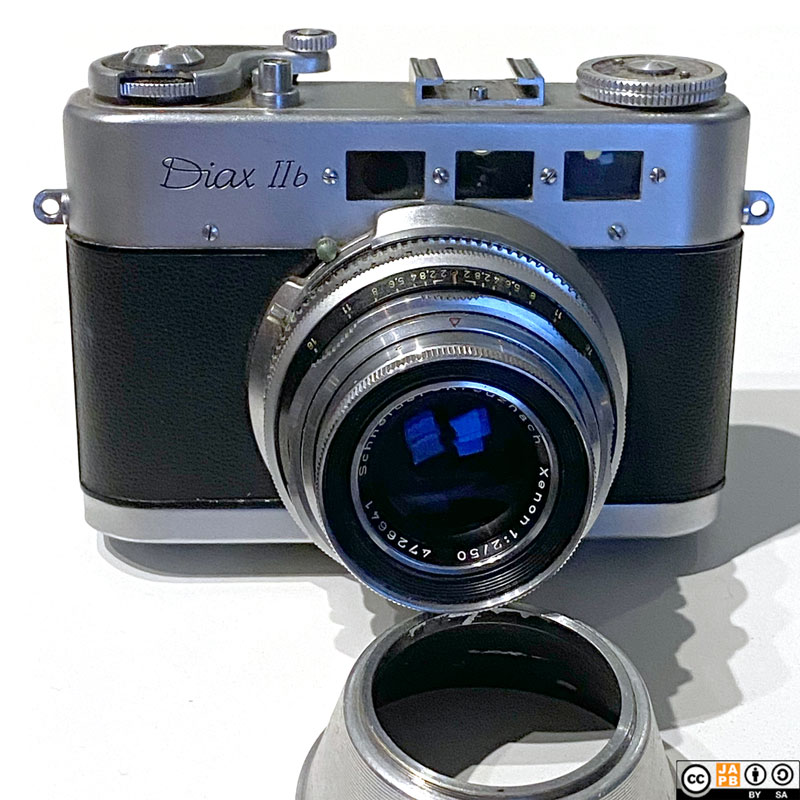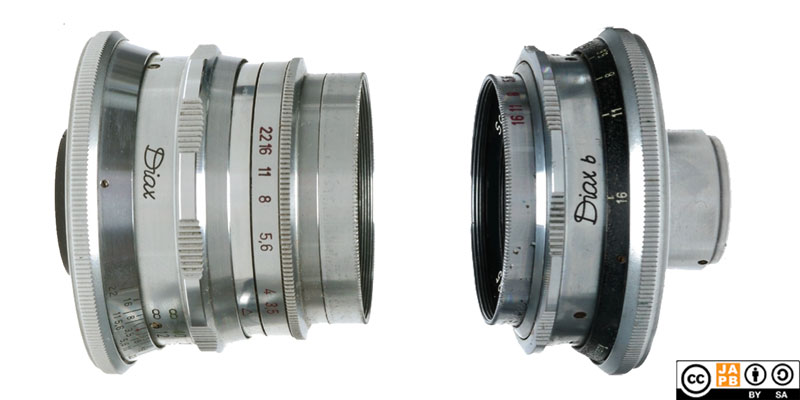Pekka Buttler, May 2025
Introduction
This article is about the lens mount by Diax’ interchangeable lens viewfinder/rangefinder cameras and lenses.
Specifications and identification
Mount type: breech-lock/thread hybrid1
Flange focal distance: 40,6 mm2
Film format: 36mm x 24mm (‘Full frame’)
Mount communication: Focusing distance (lens-to-camera)3.

Key characteristics of the mount of Diax lenses (image oriented so that lens top is up):
[1] fastening ring with threads on the inside.
[2] rangefinder cam (moves in tandem with focusing motion) to communicate focusing distance to body (Diax B lenses).
[3] location of rangefinder cam on Diax (Ia/IIa lenses)
Historical context of the Diax interchangeable lens cameras
In 1947 The Company Walter Voss (Often engraved or embossed on cameras as ‘W.Voss’) in Ulm (West Germany) started manufacturing a rangefinder camera called the ‘Diax’. in 1952 W.Voss launched the Diax Ia, which offered a mount for interchangeable lenses (but not a rangefinder). That same mount remained when W.Voss in 1954 introduced the Diax IIa, this time including a coupled rangefinder.
The Ia (interchangeable lens, no rangefinder) and IIa (interchangeable lens, coupled rangefinder) were replaced in 1956 by the Ib and IIb, which offered a modernised design and a lever for winding the film.

The Diax interchangeable lens rangefinders are one of those cameras that are sometimes referred to as a poor man’s Leica – an epithet that invariably seems to be associated with financial ruin. So too W.Voss ended production at the end of 1957.
One Diax mount or two Diax mounts?
I sometimes think that you cannot have a 1950s West German lens mount without it having some genuinely baffling quirks. So too with the Diax mount. For instance you will likely (if you have been looking at Diax lenses) have noticed that some lenses are marked Diax and others are marked Diax b (see below).

Right: lens marked ‘Diax b’ (Schneider-Kreuznach Xenar 50/2.8)
First, the good news: If you have found a way to adapt one Diax lens, it will very likely work for any Diax lens, as the mounting system/fastening ring and flange focal distance stayed the same throughout.
Also: If you have a Diax interchangeable lens camera and lens, these will very likely be compatible (there are some exceptions mentioned below).
But: Going from the Ia/IIa to the Ib/IIb in 1956, the position of the rangefinder feeler was changed, meaning that while you can mount lenses intended for the Ia/IIa (those marked Diax) on a Diax Ib/IIb, they will be mounted ‘sideways’ (the lens’ up will be pointing to the left) and if you mount lenses marked Diax b on a Ia/IIa camera the lens’ up will be pointing to the right.
And I did mention some exceptions: It seems that some of the first lenses introduced for the Diax Ia in 1952 were not yet designed with the up&coming coupled rangefinder models (IIa and IIb) in mind, and in general the recommendation is that these models should not be mounted on rangefinder-equipped models (see details below).
Diax lenses
The following table summarises a range of internet sources information on available Diax-mount lenses
| Manufacturer & Model | Focal length | Maximum aperture | Optical design (if known) | Variants (Diax / Diax b) | Compatibility |
| Schneider-Kreuznach Xenagon | 35 mm | f/3.5 | 4 elements | Diax & Diax b | All models |
| ISCO Westron | 35 mm | f/3.5 | 4 elements | Diax b | All models |
| Schneider-Kreuznach Xenar | 45 mm | f/2.8 | 4 elements | Diax & Diax b | All models |
| Laack Diaxar | 50 mm | f/3.5 | 3 elements | Diax | Ia/Ib |
| Optische Werke Göttingen Westar / ISCO Westar4 | 50 mm | f/3.5 | 3 elements | Diax | Ia/Ib |
| Schneider-Kreuznach Xenar | 50 mm | f/2.8 | 4 elements | Diax & Diax b | All models |
| Schneider-Kreuznach Xenon | 50 mm | f/2 | 6 elements | Diax & Diax b | All models |
| ISCO Isconar | 85 mm | f/4.5 | 3 elements | Diax & Diax b | All models |
| Schneider-Kreuznach Tele-Xenar | 90 mm | f/3.5 | 4 elements | Diax & Diax b | All models |
| Schneider-Kreuznach Tele-Xenar | 135 mm | f/4 | 4 elements | Diax & Diax b | All models |
Adapting Diax lenses
First off, you can use Diax lenses in their native environment on a Diax camera. While W.Voss has long since gone out of business, it seems that the cameras generally were very well manufactured and functioning cameras can still be had..
The main challenge in adapting Diax lenses is that there seems to be no serially manufactured adapters available. That said, there are some cottage industry manufacturers who offer adapters on eBay (and similar platforms). Alternatively you can use a 3D printer5 or a defunct Diax body, some tools and the nerve to use them.
The Diax mount’s flange focal distance is 40,6 mm, which makes it rather unlikely that you would find a way to successfully adapt Diax lenses to any type of SLR or dSLR.
If, on the other hand, your goal is to adapt your Diax lenses to any type of mirrorless camera, the main challenge is finding or constructing a suitable adapter.
Further reading:
Dr. Peter Geisler’s re-lifed Diax site
Footnotes:
- The fastening/unfastening of the lens to the body is facilitated through inserting the lens at its final position and rotating a fastening ring (so it is a breech-lock mount). On the other hand, that fastening ring has threads, so you would be excused for classifying this a thread-mounted lens. ↩︎
- Measured using caliper. ↩︎
- See details under ‘lenses’ ↩︎
- Originally branded “Optische Werke Göttingen”, later branded ISCO. ↩︎
- … and the skills to design a CAD file. ↩︎